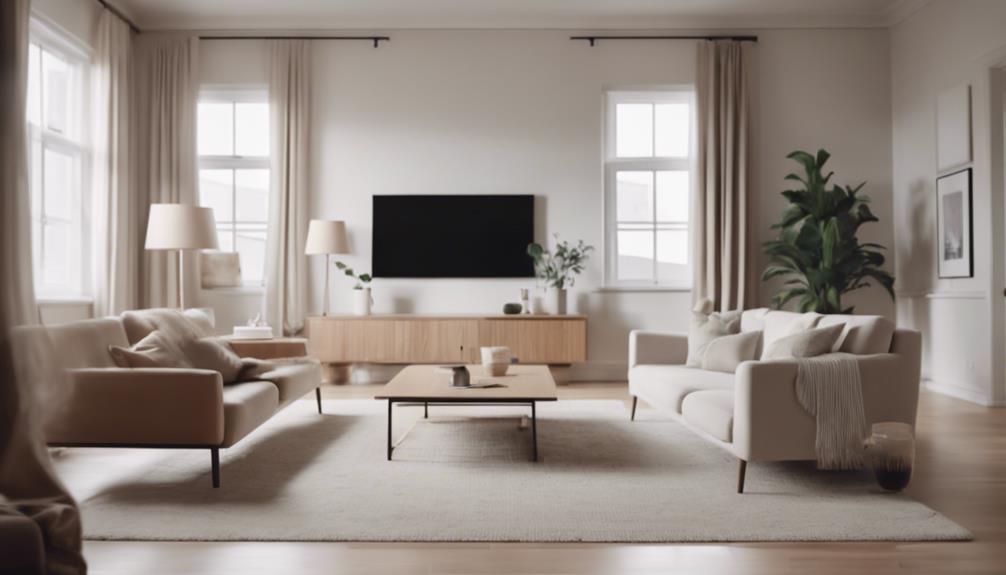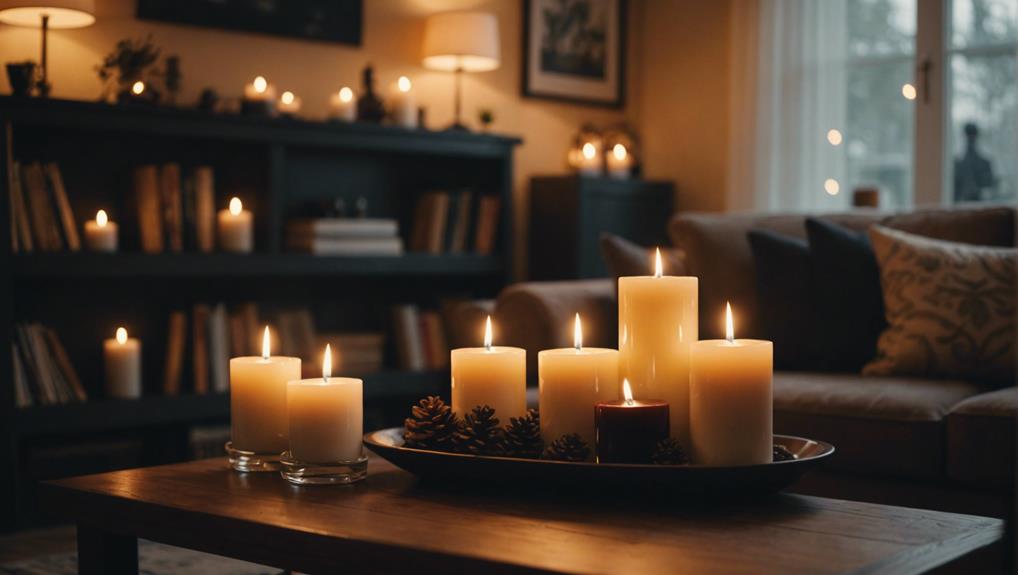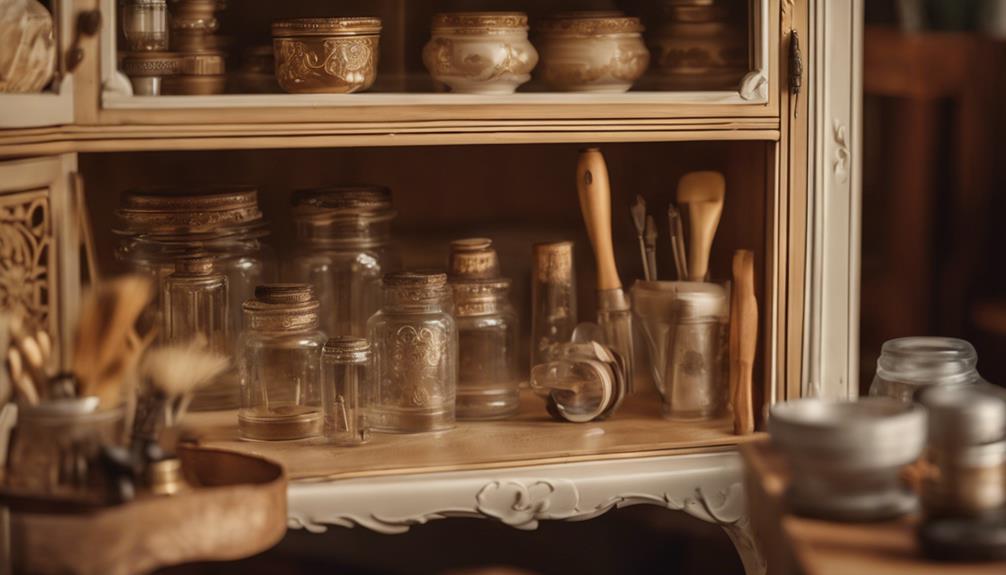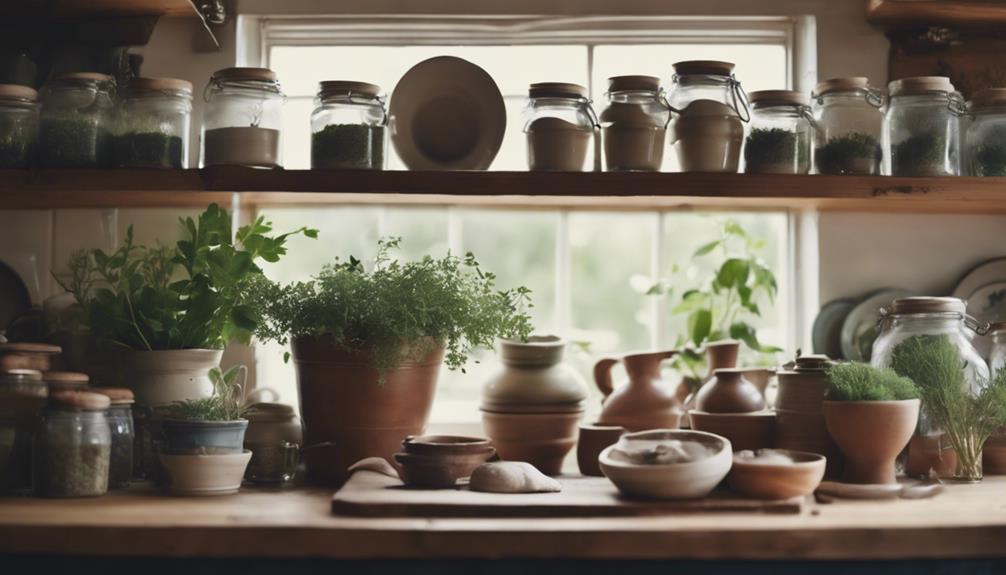Minimalist home decor is all about simplicity and functionality, removing any excess to highlight the essential elements of your interior. This design concept originated in the mid-20th century as a response to the excessive consumer culture. Some key features include clean lines, neutral colors, and natural materials such as wood. The idea behind this philosophy is to create a visually calming and mentally decluttering space with a welcoming, serene atmosphere. To achieve a minimalist aesthetic, opt for a simple color palette, minimalist furniture, and make the most of natural light. Practical storage solutions and a tranquil bedroom design are also crucial elements. For further insights on minimalist decor, check out tips for every room in your home.
Key Takeaways
- Emphasizes simplicity and functionality in design.
- Focuses on clean lines and uncluttered spaces.
- Utilizes neutral colors and natural elements like wood.
- Strives for a serene atmosphere and visual calm.
- Incorporates smart storage solutions and minimalist accessories.
History of Minimalist Home Decor
Minimalist home decor emerged in the mid-20th century as a response to the excesses of consumer culture, emphasizing simplicity and functionality. This design approach sought to strip away unnecessary elements and focus on essential aspects of interior spaces. The history of minimalist home decor is deeply rooted in the idea of living with only what's necessary, promoting a sense of calm, order, and visual harmony in living spaces.
Influenced by the minimalist art movement, minimalist home decor emphasizes clean lines, open spaces, and a monochromatic color palette. This style of design is characterized by a lack of clutter, the use of natural materials like wood and stone, and a focus on essential elements. By embracing minimalism, individuals were encouraged to make intentional design choices that fostered a decluttered environment conducive to mindful living.
Key Characteristics of Minimalist Decor
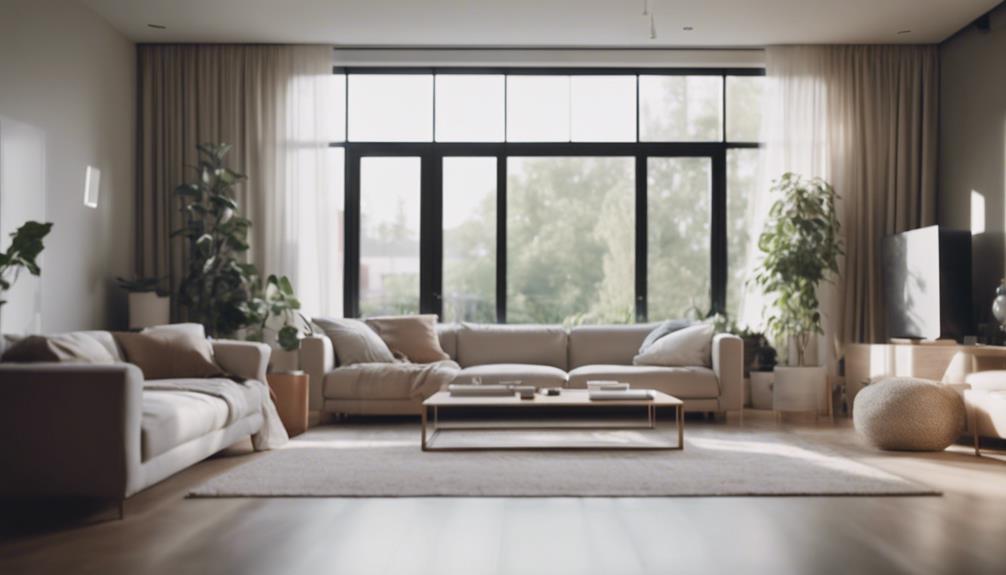
After exploring the historical roots of minimalist home decor and its connection to intentional living, let's now outline the key characteristics that define this design approach.
Minimalist decor is all about simplicity, with clean lines and uncluttered spaces taking center stage. The use of neutral colors such as whites, grays, and blacks creates a calm and open feel in minimalist interiors. Natural elements like wood, stone, and metal are incorporated to add texture and warmth to the space, enhancing the minimalist lifestyle.
Furniture in minimalist decor follows a streamlined design philosophy, free of fancy frills, to maintain a cohesive and harmonious look. Smart storage solutions and simple accessories play an essential role in minimalist home decor, ensuring that the space remains clean, organized, and clutter-free. By focusing on these key characteristics, minimalist decor creates a serene environment that promotes relaxation and a sense of clarity in the living space.
Benefits of Minimalist Interior Design
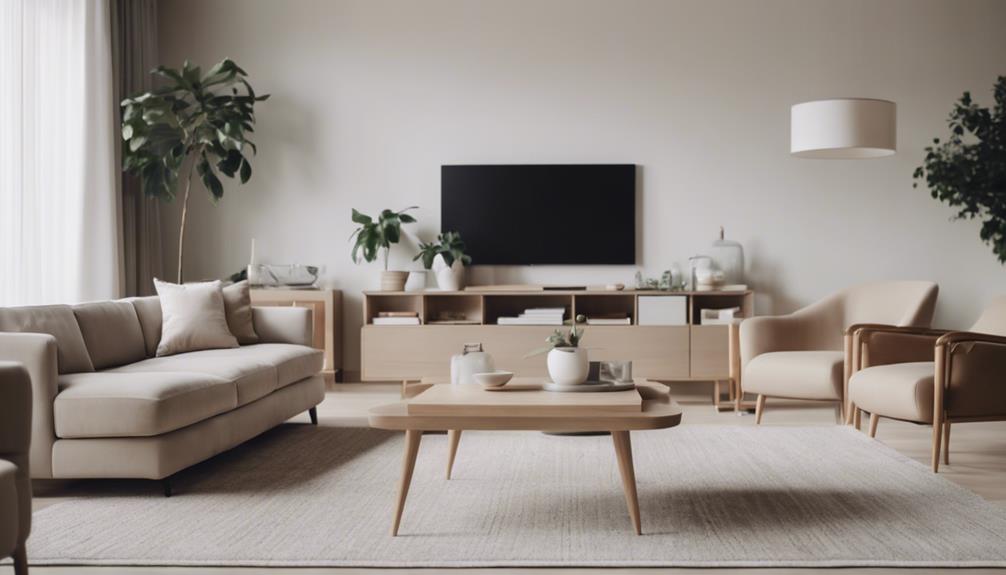
Promoting visual calm and mental decluttering, minimalist interior design creates welcoming and serene living spaces. By embracing simplicity and essential elements, minimalist interior design fosters a sense of relaxation in the home.
The emphasis on clean, clutter-free environments helps to establish a serene atmosphere that feels inviting and tranquil. While minimalist design focuses on functionality and practicality, it also incorporates warmth to prevent spaces from appearing cold or sterile.
This blend of practicality and warmth enhances the beauty of simplicity, making minimalist interior design both aesthetically pleasing and functional. Overall, the benefits of minimalist interior design lie in its ability to create spaces that aren't only visually appealing but also conducive to a sense of peace and tranquility.
The practical aspects of minimalist design work harmoniously with the warmth and simplicity to cultivate a living environment that promotes well-being and comfort.
Minimalist Color Palette Choices
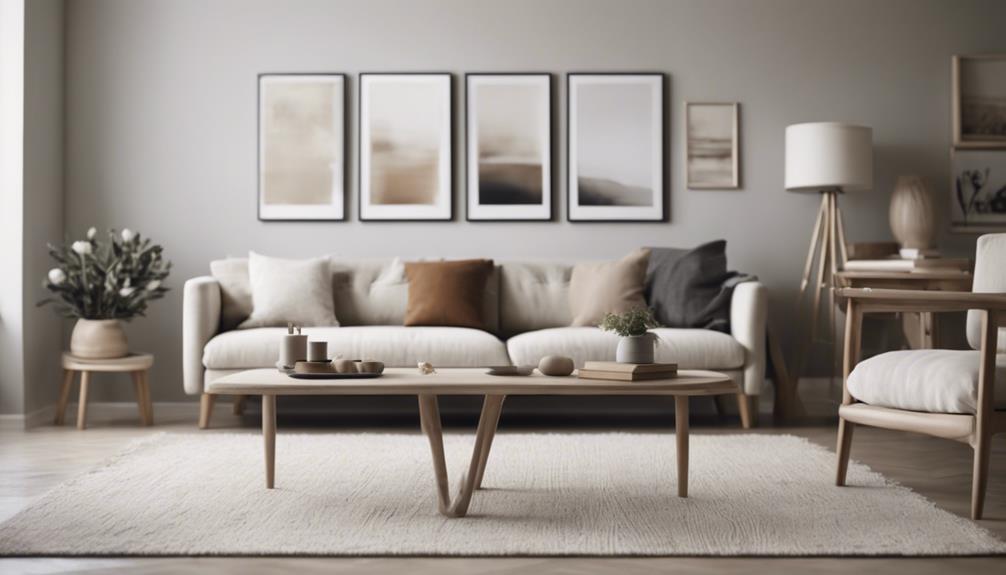
When contemplating minimalist color palette choices for your home decor, it's crucial to focus on a neutral color scheme, incorporating whites, grays, and blacks. These colors create a serene and uncluttered ambiance, allowing for a clean and sophisticated look.
While adhering to neutral tones, integrating a pop of color strategically can add visual interest and personality to the space.
Neutral Color Scheme
Utilizing neutral hues like whites, grays, and blacks forms the cornerstone of a minimalist color palette, creating a serene and spacious ambiance in home decor. In minimalist style, white walls are often chosen to enhance the feeling of simplicity and cleanliness.
These neutral colors not only provide a calming backdrop but also allow other design elements to stand out without overpowering the space. Minimalist decor frequently employs a monochromatic palette, where different shades of a single color are used to maintain a cohesive and uncluttered look.
The use of a neutral color scheme in minimalist design emphasizes sophistication and elegance while promoting a sense of tranquility and minimalism within the living space.
Monochromatic Design Elements
In minimalist home decor, the integration of monochromatic design elements, such as whites, grays, and blacks, guarantees a cohesive and visually harmonious aesthetic. Embracing a monochromatic color palette in minimalist design offers various benefits that contribute to the overall feel of the space:
- Minimalist design aesthetic: Monochromatic colors align with the essence of minimalism, emphasizing simplicity and functionality.
- Visual harmony: The use of a single color family creates a sense of balance and unity throughout the room.
- Timeless aesthetic: Monochromatic schemes have a classic appeal that transcends trends, ensuring longevity in style.
- Reduced visual distractions: By limiting the color palette, monochromatic design reduces clutter and allows key elements to shine in the space.
Pop of Color
To enhance the minimalist aesthetic with a touch of vibrancy, consider incorporating a carefully chosen pop of color into your decor.
While minimalist design typically revolves around a neutral color palette of whites, grays, and blacks, adding a pop of color through accent pieces can bring visual interest and personality to the space.
Opt for a single hue that contrasts with the neutral backdrop to create a striking visual impact. This pop of color can be introduced through items like cushions, artwork, or a statement furniture piece, serving as focal points that draw attention without overwhelming the overall simplicity of the design.
Furniture Selection for Minimalist Spaces
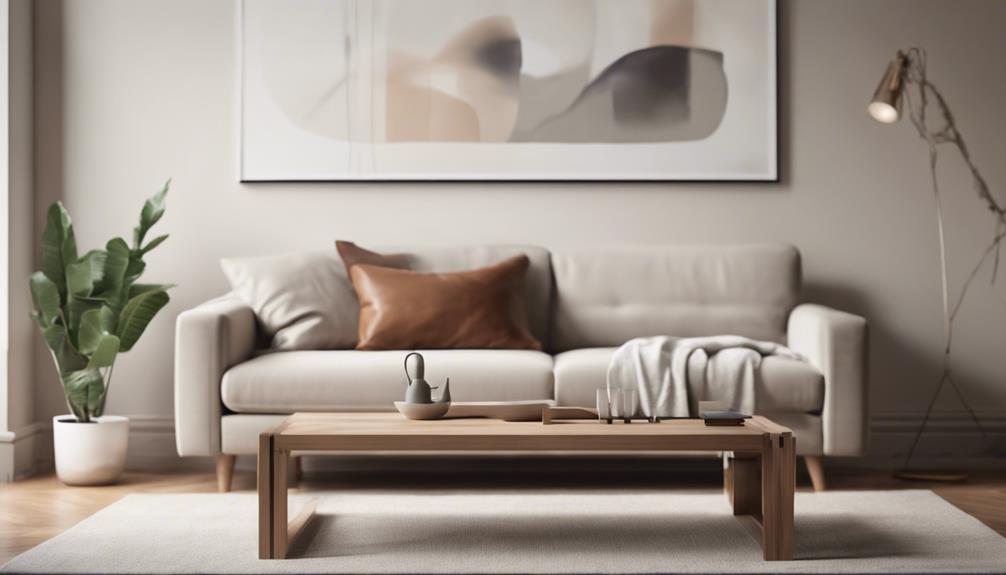
When furnishing minimalist spaces, it's essential to opt for furniture with clean lines and simple designs.
Choosing pieces made of natural materials like wood, metal, or stone can add warmth and an organic touch to the room.
To maximize functionality, consider selecting furniture that serves a dual purpose, such as items with hidden storage options.
Essential Furniture Pieces
Opting for essential furniture pieces is key when outfitting minimalist spaces for a sleek and uncluttered look. When selecting furniture for a minimalist home decor, consider these items:
- A sleek sofa with clean lines and a minimalistic design to serve as the focal point of the living room.
- Simple coffee table or side table made of natural materials such as wood or metal for a touch of warmth.
- Functional storage solutions like a minimalist bookshelf or a sleek media console to keep items organized and maintain the clean aesthetic.
- Minimalist dining table with a simple design and neutral color palette to anchor the dining area without overwhelming the space.
These furniture pieces embody the essence of minimalist design, creating a harmonious and serene atmosphere in your living spaces.
Neutral Color Schemes
Choosing furniture pieces with neutral color schemes is fundamental for creating a serene and cohesive minimalist space. Neutral colors like whites, grays, and blacks help reduce visual clutter, promoting a sense of spaciousness even in smaller rooms. Furniture with clean lines and no elaborate details enhances the flow and fits well in minimalist spaces. To add warmth and texture, consider incorporating natural elements such as wood, stone, and metal in your furniture and decor. This combination of neutral colors and natural elements fosters a calm and open ambiance, allowing other design elements to shine while maintaining simplicity and elegance.
| Neutral Color Schemes in Minimalist Home Decor | ||
|---|---|---|
| Reduce visual clutter | Create a sense of spaciousness | Enhance simplicity and elegance |
Functional Space Utilization
To maximize space utilization in minimalist home decor, our focus shifts towards selecting furniture that embodies functionality and practicality. In minimalist spaces, furniture with clean lines and simple designs is favored to maintain a clutter-free environment.
When choosing furniture for a minimalist home, consider multifunctional pieces like storage ottomans or nesting tables. These items not only serve their primary function but also provide additional storage or versatility. In a minimalist setting, furniture selection is deliberate, aiming to avoid unnecessary items that can clutter the space.
The goal is to curate a harmonious environment with a visually appealing aesthetic, free of distractions.
Incorporating Natural Elements in Decor
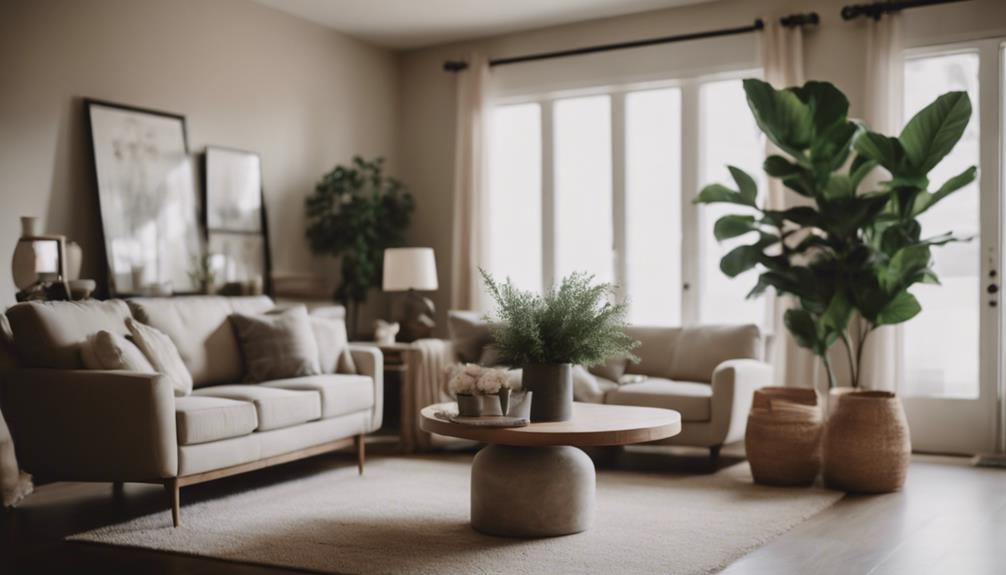
In minimalist home decor, we consistently find that incorporating natural elements like wood, stone, and metal enhances the overall aesthetic with texture and warmth. By integrating these organic materials, we can create a soothing ambiance that connects the space to nature, enhancing the minimalist design. Hand-hewn exposed beams and marble, for instance, can serve as striking focal points in a minimalist decor, adding a touch of elegance and sophistication. Additionally, subtle hints of rustic elements can be introduced to provide contrast and visual interest in an otherwise clean and uncluttered space.
To further illustrate how natural elements can transform a minimalist home, consider the following table:
| Natural Materials | Enhancing Minimalist Decor |
|---|---|
| Wood | Adds warmth and texture |
| Stone | Provides a sense of calm |
| Metal | Offers a sleek aesthetic |
| Marble | Creates a luxurious feel |
| Exposed Beams | Adds a touch of rustic charm |
Integrating these elements thoughtfully can elevate the overall look and feel of a minimalist space, emphasizing simplicity and natural beauty simultaneously.
Maximizing Natural Light in Minimalist Homes
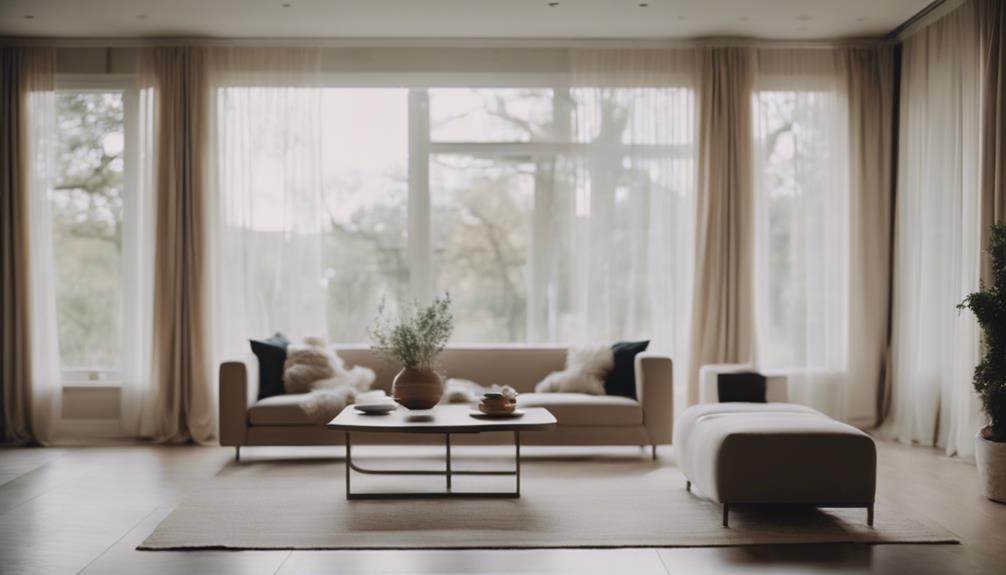
Maximizing natural light in minimalist homes plays an essential role in creating an open and expansive ambiance, complementing the incorporation of natural elements for a harmonious design. To achieve this, consider the following:
- Large Windows: Installing large windows allows abundant natural light to flood the space, enhancing the minimalist home decor.
- Reflective Surfaces: Incorporating mirrors and reflective surfaces helps bounce light around the room, creating a brighter and more spacious feel.
- Skylights: Utilizing skylights or light tubes is a great way to introduce natural light from above, adding a unique touch to minimalist interiors.
- Control Options: Using sheer curtains or blinds gives you the flexibility to adjust the amount of light entering the room while maintaining the clean and uncluttered aesthetic.
Minimalist Storage Solutions
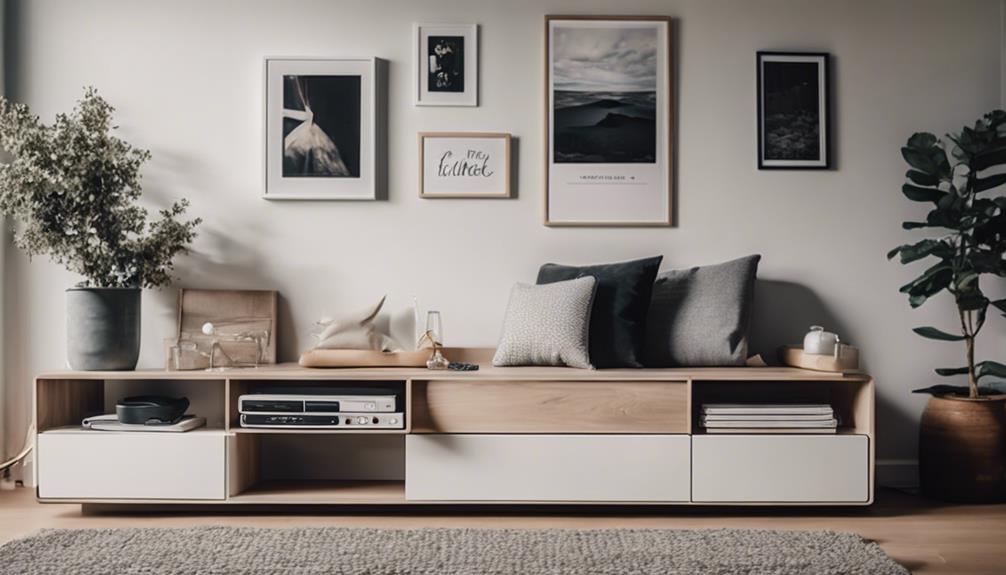
Minimalist storage solutions in home decor often prioritize sleek designs that utilize push-latch closures and concealed appliances for a clean and uncluttered look. By skipping visible hardware and opting for push-latch closures on cabinets, the aesthetic remains streamlined and modern.
In minimalist kitchens, the use of concealed appliances helps maintain the uncluttered feel, with panel-ready appliances being a popular choice to seamlessly blend into cabinetry for a cohesive look. This seamless blending of elements extends to other spaces as well, with concrete backsplashes and countertops often chosen to create a unified and clutter-free storage solution.
Emphasizing simplicity and functionality, minimalist storage solutions aim to create a sense of calm and order within a space while still being visually appealing. The key lies in the integration of design elements to achieve a harmonious and serene environment that's both practical and beautiful.
Creating Serene Minimalist Bedrooms
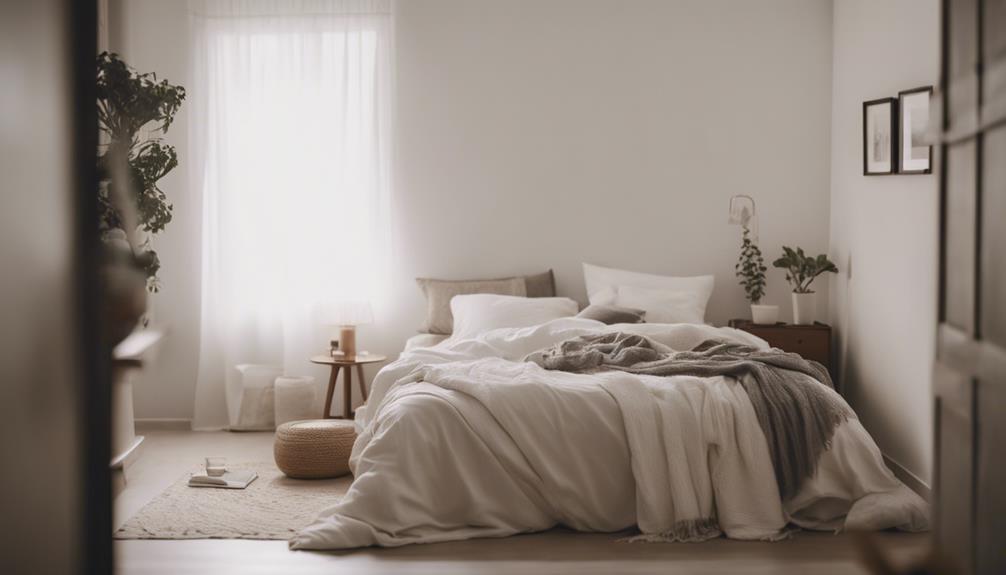
Moving from minimalist storage solutions, let's now explore how to cultivate serene minimalist bedrooms.
When designing a serene minimalist bedroom, consider the following:
- Neutral Color Palettes: Opt for whites, beiges, and greys to create a calming ambiance.
- Natural Materials: Incorporate wood, stone, and cotton to add warmth and texture to your bedroom decor.
- Essential Furniture Pieces: Focus on minimalist essentials like platform beds, simple dressers, and unobtrusive nightstands.
- Decluttering and Smart Storage: Keep surfaces clear and utilize hidden drawers or under-bed storage to maintain the minimalist aesthetic.
Minimalist Decor Tips for Every Room
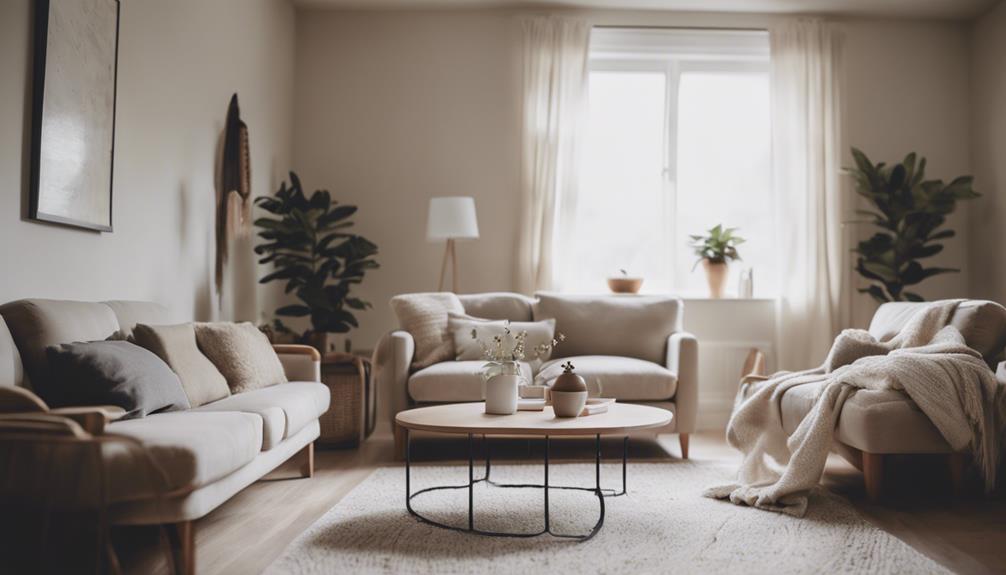
When designing a minimalist space, essential furniture placement and a neutral color palette are key factors to take into account. These elements help create a sense of openness and tranquility in every room.
Essential Furniture Placement
Strategically placing furniture in each room is essential for achieving an open and uncluttered space in minimalist home decor. When it comes to furniture placement in minimalism, consider these key points:
- Flow: Arrange furniture to create a harmonious flow that allows for easy movement throughout the room.
- Functionality: Position pieces to serve their intended purpose efficiently, avoiding unnecessary clutter.
- Space: Opt for furniture that maximizes space without overcrowding, maintaining a sense of openness.
- Organization: Keep furniture placement organized and visually appealing to enhance the overall minimalist design.
Neutral Color Palette
To achieve a serene and uncluttered ambiance in minimalist home decor, incorporating a neutral color palette is key for enhancing the overall aesthetic of every room. Neutral tones like whites, grays, and blacks create a calm and open feel, allowing other elements in the room to stand out and promoting simplicity.
These colors help minimize distractions and maintain a clean, uncluttered look in every space. By using a neutral color scheme, you can enhance the flow and visual appeal of minimalist rooms. Additionally, neutral colors provide a versatile backdrop for minimalist decor, making it easier to coordinate with different design elements.
Embracing a neutral color palette is a fundamental step towards achieving the desired minimalist look in your home.
Frequently Asked Questions
What Is Minimalist Decorating Style?
Minimalist decorating style is all about simplicity, clean lines, and uncluttered spaces. It focuses on functionality over ornate decorations to create a calming atmosphere.
Neutral colors such as whites, greys, and beiges are commonly used. Natural materials like wood, stone, and metal add texture and warmth.
Smart storage solutions and minimal accessories are key in achieving this aesthetic.
What Does a Minimalist Home Look Like?
A minimalist home embodies simplicity, featuring clean lines, neutral colors, and uncluttered spaces to create a serene and spacious environment.
Furniture is streamlined with no elaborate details, promoting a cohesive and calming atmosphere. Decorations are minimal yet carefully selected to add character without overwhelming the space.
An open layout enhances the sense of freedom and movement, while incorporating natural elements like wood and metal brings warmth and a connection to nature for a soothing ambiance.
What Is a Minimalist Interior Concept?
A minimalist interior concept prioritizes simplicity, clean lines, and uncluttered spaces. It focuses on functionality, essential elements, and a monochromatic color palette. This design promotes a sense of calm, tranquility, and visual decluttering.
Incorporating natural materials, textures, and warmth helps balance minimalist spaces. Originating in the 60s and 70s, it was influenced by minimalist art movements and modern design principles.
Why Do People Like Minimalist Decor?
We like minimalist decor for its calming, uncluttered vibe, promoting relaxation. It emphasizes quality items over quantity, making spaces easier to maintain.
Its timeless appeal avoids trends, fostering mindfulness and intentionality in design choices. The simplicity of minimalist decor not only looks good but also encourages a more thoughtful lifestyle.
How Can I Incorporate Minimalist Elements into My Home Decor Aesthetic?
Incorporating minimalist elements into your home decor aesthetic can create a sleek and sophisticated look. To discover your home decor aesthetic, consider decluttering and using a neutral color palette. Opt for clean lines and simple furniture to achieve a minimalist vibe, while adding natural textures for warmth and depth.
Conclusion
To sum up, minimalist home decor is a design style that emphasizes simplicity, functionality, and clean lines. It promotes a sense of calm and clarity in your living space, making it easier to relax and focus.
By decluttering and focusing on quality over quantity, minimalist decor can transform your home into a peaceful retreat.
So, embrace the minimalist lifestyle and experience the joy of living in a space that feels like a serene sanctuary.
